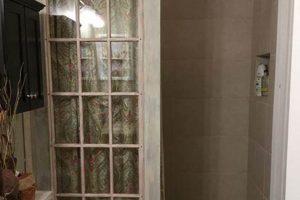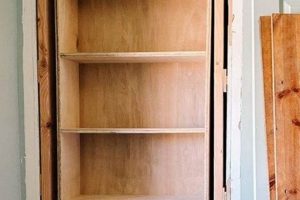A door constructed at home using individual sections fitted within a frame, often employing readily available materials and basic tools, represents a significant undertaking in home improvement. This type of construction involves assembling a structure where flat components are secured within a perimeter framework, providing both aesthetic appeal and functional closure to an opening.
Creating this type of entry solution offers several advantages, including customization to specific dimensions and design preferences, and potential cost savings compared to professionally manufactured options. Historically, constructing doors from individual elements was a common practice, allowing for efficient use of materials and adaptation to various architectural styles, contributing to the evolution of interior and exterior design.
The following discussion will explore the selection of suitable materials, essential tools, and step-by-step instructions for successfully fabricating such a structural element, emphasizing best practices for achieving a durable and visually appealing final product.
Construction Considerations for Assembled Doors
The following guidelines aim to optimize the construction process and ensure the longevity and aesthetic appeal of a door assembled from individual components.
Tip 1: Material Selection: Prioritize the selection of wood that is both structurally sound and resistant to warping. Kiln-dried hardwoods, such as poplar or oak, are often preferred due to their stability and ability to accept finishes evenly.
Tip 2: Precise Measurements: Accurate measurement of the door opening is paramount. The constructed frame should be slightly smaller than the opening to allow for ease of installation and potential adjustments.
Tip 3: Frame Assembly: Utilize strong joinery techniques, such as mortise and tenon or dowel joints, to ensure the frame’s structural integrity. Reinforce joints with high-quality wood glue and clamps during the drying process.
Tip 4: Panel Construction: Employ floating panels within the frame to accommodate wood expansion and contraction due to changes in humidity. This prevents warping and cracking over time.
Tip 5: Surface Preparation: Thoroughly sand all surfaces to create a smooth and even finish. This is crucial for optimal paint or stain adhesion and a professional appearance.
Tip 6: Finishing Application: Apply multiple thin coats of finish, allowing each coat to dry completely before applying the next. This provides enhanced protection against moisture and wear.
Tip 7: Hardware Installation: Select high-quality hinges, handles, and latches that complement the door’s style and function. Ensure proper alignment and secure attachment for smooth operation.
Adhering to these guidelines will contribute significantly to the successful fabrication of a durable and aesthetically pleasing door assembly, enhancing the value and functionality of the structure it serves.
The subsequent sections will delve into advanced techniques and troubleshooting common issues encountered during the construction process.
1. Material Durability
Material durability is a critical factor in the successful construction and longevity of a door assembled from components. The chosen material dictates the door’s resistance to environmental stressors, physical wear, and potential decay. For instance, softwood panels, while less expensive, are more susceptible to dents, scratches, and moisture absorption compared to hardwoods like oak or mahogany. The resulting damage compromises the door’s aesthetic appeal and structural integrity, potentially necessitating premature repairs or replacement. Therefore, careful consideration of material properties is paramount to ensuring a durable and cost-effective outcome.
The selection of durable materials extends beyond the panels themselves to include the frame and connecting components. Using inferior adhesives or fasteners can lead to joint failure, compromising the door’s structural stability, even if the panels are constructed from robust materials. In regions with high humidity or extreme temperature fluctuations, employing weather-resistant hardwoods and appropriate sealants becomes particularly crucial. Real-world examples demonstrate that doors made with inadequate materials often exhibit warping, cracking, and rot within a relatively short period, highlighting the direct correlation between material durability and the door’s lifespan.
In conclusion, understanding the connection between material durability and the performance of doors built from sections is essential for making informed decisions during the construction process. Selecting appropriate materials, based on factors like climate, usage patterns, and budget, directly impacts the door’s long-term functionality and appearance. Prioritizing material durability is not merely a matter of aesthetics but a practical investment that minimizes future maintenance costs and ensures the door remains a reliable and visually pleasing feature of the structure it serves. The ultimate challenge lies in balancing cost considerations with the imperative to choose materials that provide adequate resistance to the environmental and physical demands the door will face throughout its service life.
2. Accurate Dimensions
The successful fabrication of a door composed of discrete sections hinges fundamentally on accurate dimensions. Deviations from precise measurements during any stage of construction, from frame assembly to panel creation, inevitably lead to functional impairments and aesthetic compromises. The correlation is direct: inaccurate dimensions cause misalignments, compromised structural integrity, and operational difficulties. An undersized frame, for example, results in an unstable installation, while an oversized frame prevents proper closure. Similarly, discrepancies in panel dimensions create unsightly gaps or force-fitting, leading to potential warping or cracking over time. The creation of such a structural element demands exacting adherence to specified measurements, where even minor errors cascade into significant problems.
Consider the practical implications of dimensional inaccuracies in a real-world scenario. A homeowner constructs a door composed of elements for a standard 30-inch doorway but fails to account for the thickness of the doorframe itself. The resulting door, built to 30 inches, cannot swing freely within the frame. The homeowner faces the arduous task of resizing the door, a process that risks damaging the structure and compromising the overall aesthetic. Conversely, imagine a case where an individual constructs the doorframe accurately, but the created sections are slightly smaller. The door, while fitting, leaves unwanted gaps that allow drafts and reduces the door’s effectiveness as a barrier against sound and weather. These examples highlight the tangible consequences of neglecting precise measurement in the construction process.
In conclusion, accurate dimensions constitute a non-negotiable prerequisite for the successful realization of any door assembled from sections. Challenges related to dimensional accuracy can be mitigated through meticulous planning, employing precise measuring tools, and verifying all measurements before committing to cuts. The ultimate goal is to achieve a finished product that functions flawlessly, provides adequate security, and contributes positively to the overall aesthetic of the structure it serves. The connection between accurate dimensions and a successfully realized structural element is undeniable and represents a foundational principle in construction practices.
3. Joint Strength
The structural integrity of a door constructed from discrete components is inextricably linked to the strength of its joints. These junctions, where individual pieces of wood or other materials are connected, bear the brunt of the stresses imposed by daily use, environmental fluctuations, and the weight of the door itself. Weak or poorly executed joints are a primary cause of door failure, leading to sagging, warping, and eventual separation of the components. Consequently, the selection and implementation of appropriate jointing techniques are paramount to ensuring the longevity and functionality of doors assembled in a home workshop setting. The cause-and-effect relationship is direct: insufficient joint strength results in diminished door performance and a reduced lifespan, whereas robust joints provide the necessary stability to withstand the forces acting upon the structure.
Various jointing methods are available to the home builder, each with its own advantages and disadvantages. Mortise and tenon joints, known for their exceptional strength and resistance to racking forces, are a traditional choice for door frames. However, they require precise execution and specialized tools. Dowel joints offer a simpler alternative, particularly for lighter doors or secondary components, but lack the inherent strength of mortise and tenon joints. Pocket screw joinery, while quick and easy to implement, may not provide adequate long-term stability in high-stress areas. Examples of joint failure abound in poorly constructed doors. Sagging doors, common in older homes, often result from weakened or degraded joints within the frame. Cracked or separated frame members are further indicators of inadequate joint strength, highlighting the practical significance of understanding and implementing proper jointing techniques. Choosing the right joint and executing it properly directly determines the door’s overall performance and lifespan.
Ultimately, the achievement of sufficient joint strength in a door comprised of individual elements depends on a combination of factors: appropriate joint selection, precise execution, and the use of high-quality adhesives. While the home builder may face challenges in replicating the precision of factory-made doors, a thorough understanding of jointing principles and a commitment to careful craftsmanship can yield a durable and aesthetically pleasing result. Ignoring this critical aspect jeopardizes the entire project, rendering the final product susceptible to premature failure. Therefore, ensuring adequate joint strength is not merely a technical detail, but a fundamental prerequisite for creating a functional and long-lasting door.
4. Panel Stability
Panel stability is a critical determinant of the overall quality and longevity of a structural element constructed from discrete sections. The propensity of a panel to warp, twist, or crack directly affects the aesthetic appeal and functional performance. Unstable panels detract from the visual consistency of the finished product and can compromise the door’s ability to provide a secure and weather-tight closure. The absence of panel stability results in diminished structural integrity and reduced resistance to environmental stressors. Consider, for example, a raised panel door where the panels are not adequately secured or are constructed from improperly seasoned wood. These panels will likely expand and contract with humidity changes, leading to warping and potential cracking. Consequently, the door becomes difficult to operate, and its insulating properties are significantly reduced.
Achieving panel stability requires careful consideration of several factors, including material selection, construction techniques, and finishing practices. Wood panels should be properly kiln-dried to minimize moisture content and reduce the likelihood of warping. Utilizing floating panel construction allows for natural expansion and contraction without placing undue stress on the surrounding frame. Furthermore, applying a protective finish to all surfaces of the panel helps to regulate moisture absorption and prevent uneven drying. A practical illustration of the impact of these factors can be observed in antique doors where the original construction methods failed to account for panel movement. These doors often exhibit significant warping and splitting, necessitating extensive restoration work to restore their structural integrity and aesthetic appeal.
In conclusion, panel stability is not merely a cosmetic concern but a fundamental aspect of durable door construction. Addressing panel stability requires a comprehensive approach that integrates appropriate material selection, sound construction techniques, and protective finishing practices. The challenges associated with achieving panel stability can be overcome through careful planning and diligent execution, resulting in a structural element that provides lasting performance and enhances the aesthetic value of the space it occupies. The pursuit of panel stability is an investment in the long-term functionality and visual quality, underscoring its central role in achieving overall excellence.
5. Surface Preparation
Surface preparation is a foundational element in the fabrication of a door constructed from discrete components. It dictates the adhesion, appearance, and longevity of subsequent finishes, directly influencing the overall quality and durability of the door. Neglecting proper surface preparation undermines the structural integrity and aesthetic value of the final product.
- Sanding and Smoothing
Sanding removes imperfections such as milling marks, scratches, and raised grain, creating a uniform substrate for paint or stain. Sanding also opens the wood pores. A poorly sanded surface will result in uneven finish absorption, visible imperfections, and reduced adhesion. For example, failing to properly sand a panel edge before applying paint can lead to paint chipping or peeling at that edge over time. The grit progression, from coarse to fine, is critical for achieving an optimal finish.
- Cleaning and Dust Removal
Contaminants such as dust, grease, and oils impede finish adhesion and can create surface blemishes. Thorough cleaning with appropriate solvents or tack cloths is essential prior to applying any coating. The presence of even minute particles of dust can result in a textured finish, diminishing the aesthetic appeal. In instances where residue remains from handling, the finish may not adhere correctly, leading to peeling or bubbling.
- Priming and Sealing
Priming serves several functions, including sealing the wood grain, providing a uniform base for the topcoat, and enhancing adhesion. Priming can also help prevent tannin bleed-through from certain wood species. Without a primer, the topcoat may absorb unevenly, resulting in a blotchy or inconsistent finish. A primer also provides a stable base for topcoats. An example is using an oil-based primer on knots to prevent the resins from bleeding through the finish.
- Filling Imperfections
Wood filler is used to address blemishes such as knot holes, gouges, and cracks, creating a smooth and uniform surface. Proper application and sanding of filler are crucial to ensure seamless integration with the surrounding wood. Failure to adequately fill and sand imperfections can result in visible defects in the finished door. If wood filler is not sanded flush it can create noticeable ridges.
In summary, diligent surface preparation is not a perfunctory step but an integral component of the construction process for doors assembled from sections. It directly impacts the final appearance, durability, and longevity of the finished product. Prioritizing these steps ensures that subsequent finishing efforts yield a professional-grade result, contributing significantly to the overall quality.
6. Hardware Selection
Hardware selection for doors constructed from components represents a critical juncture where functionality, security, and aesthetics converge. The chosen hardware dictates not only the door’s operational ease and level of protection but also its visual harmony with the surrounding architecture. Thoughtful consideration of hardware attributes is paramount to achieving a durable and aesthetically pleasing final product.
- Hinge Selection and Placement
Hinges bear the load of the door and enable its smooth operation. The number, size, and type of hinges must be appropriate for the door’s weight and dimensions. Insufficient hinges can lead to sagging or binding, while improperly placed hinges can compromise the structural integrity of the frame and door stile. For instance, a heavy solid-core door requires heavier-duty hinges than a lightweight hollow-core door to prevent premature wear and tear. The correct placement of the hinges, taking into account the doors weight distribution, is crucial for even stress distribution and prolonged functionality.
- Lockset Functionality and Security
Locksets provide security and privacy. The choice of lockset depends on the desired level of security and the door’s intended use. Entry doors typically require robust deadbolt locks, while interior doors may only need passage or privacy sets. The quality of the lock cylinder and the strike plate’s construction directly impact the door’s resistance to forced entry. A high-security deadbolt with a reinforced strike plate, properly installed, significantly enhances the door’s ability to withstand attempted breaches compared to a standard, lightweight lockset.
- Handle Style and Ergonomics
Handles serve as the primary interface for operating the door. The style of the handle should complement the door’s design and the overall aesthetic of the space. Ergonomic considerations, such as handle size and shape, enhance user comfort and accessibility. A handle that is too small or difficult to grip can create inconvenience, while a handle that clashes with the door’s style detracts from its visual appeal. Lever handles, for example, offer easier operation for individuals with limited dexterity compared to traditional doorknobs.
- Threshold and Weatherstripping Integration
The threshold and weatherstripping work in concert to seal the gap between the door and the frame, preventing drafts and moisture infiltration. The threshold should be properly aligned and securely fastened to ensure a tight seal. Weatherstripping should be chosen based on its durability, resistance to compression, and compatibility with the door and frame materials. A poorly sealed door can lead to significant energy loss and increased heating or cooling costs. Silicone weatherstripping, for example, offers excellent resistance to extreme temperatures and prolonged compression compared to foam weatherstripping.
The selection of appropriate hardware for doors built from individual components is a holistic process that requires careful consideration of functionality, security, aesthetics, and long-term performance. These components not only enable the door’s essential operation but also contribute significantly to its overall value and utility. By prioritizing quality and compatibility, the home builder can ensure a successful and satisfying result, transforming raw materials into a functional and visually pleasing entryway. Additional examples may include specialty hardware, such as barn door hardware for a rustic aesthetic, or concealed hinges for a minimalist design, demonstrating the broad spectrum of hardware options available to customize the constructed door.
7. Finish Application
The finish application phase for a door constructed from discrete sections exerts a profound influence on the overall performance and aesthetic appeal of the finished product. The finish serves as a protective barrier against environmental factors such as moisture, sunlight, and physical abrasion, preventing degradation of the underlying materials. The selection of an appropriate finish, coupled with its proper application, directly impacts the door’s longevity and resistance to warping, cracking, and decay. Inadequate or improper finish application can nullify the benefits of meticulous material selection and precise construction techniques. For instance, failing to apply a moisture-resistant finish to all surfaces of the door, including the edges and hidden areas, creates vulnerable points for water intrusion, accelerating deterioration. This necessitates premature repairs or replacements, underscoring the practical significance of thorough and informed finish application practices.
Different types of finishes offer varying levels of protection and aesthetic characteristics. Oil-based finishes provide excellent penetration and durability but may yellow over time and require longer drying times. Water-based finishes offer lower VOC emissions and faster drying times but may not provide the same level of water resistance as oil-based options. Polyurethane finishes offer superior durability and resistance to abrasion but can be more challenging to apply evenly. Real-world examples demonstrate that doors exposed to harsh weather conditions without adequate finish protection often exhibit signs of weathering, discoloration, and structural damage within a relatively short period. Conversely, doors finished with durable, weather-resistant coatings maintain their appearance and structural integrity for extended periods, reducing maintenance requirements and prolonging their lifespan. The choice of finish should therefore be informed by the specific environmental conditions to which the door will be exposed and the desired aesthetic outcome.
In conclusion, the finish application represents a critical and often underestimated aspect of constructing doors from individual components. This phase directly impacts the durability, longevity, and aesthetic appeal of the final product. Overcoming the challenges associated with proper finish application requires careful planning, selecting the appropriate finish for the intended application, and executing the application with precision. A thorough understanding of these factors and their practical implications is essential for achieving a professional-grade result and maximizing the value of the construction effort. The successful completion of a door constructed from sections hinges not only on the quality of the materials and craftsmanship employed but also on the protective and aesthetic qualities imparted by a well-executed finish application.
Frequently Asked Questions
The following questions address common inquiries and misconceptions regarding the construction of doors from individual components.
Question 1: Is specialized equipment required for assembling a door from sections?
While advanced woodworking machinery can enhance precision and efficiency, it is feasible to construct doors using basic hand tools and power tools commonly found in a home workshop. Essential tools include a saw, drill, measuring devices, and clamping equipment. However, access to a jointer and planer can significantly improve the accuracy and quality of the milled lumber.
Question 2: What type of wood is best suited for constructing doors from sections?
Hardwoods, such as oak, maple, and mahogany, are generally preferred due to their superior strength, durability, and resistance to warping. Softwoods, such as pine and fir, can be used for less demanding applications, but require careful selection and treatment to prevent premature deterioration. Kiln-dried lumber is essential to minimize moisture content and ensure dimensional stability.
Question 3: How are sections held together to ensure structural integrity?
Structural integrity is achieved through the use of strong joinery techniques, such as mortise and tenon joints, dowel joints, or rabbet joints, combined with high-quality wood glue and mechanical fasteners. Proper clamping during assembly is crucial to ensure a tight and durable bond. The specific joinery method should be selected based on the door’s design, intended use, and the builder’s skill level.
Question 4: What are the key considerations for preventing warping in a constructed door?
Preventing warping requires careful attention to material selection, construction techniques, and environmental control. Using kiln-dried lumber, employing floating panel construction to allow for wood movement, and applying a consistent finish to all surfaces are essential steps. Additionally, controlling the humidity levels in the environment where the door is installed can help minimize warping.
Question 5: How is a proper seal achieved to prevent drafts and moisture infiltration?
A proper seal is achieved through the use of weatherstripping and a well-fitted threshold. Weatherstripping should be installed around the perimeter of the doorframe to create an airtight barrier. The threshold should be adjusted to ensure a tight seal against the bottom of the door. Regular inspection and maintenance of the weatherstripping and threshold are necessary to maintain a consistent seal.
Question 6: What type of finish is recommended to protect the door from the elements?
The choice of finish depends on the door’s exposure to the elements and the desired aesthetic outcome. Exterior doors generally require a durable, weather-resistant finish, such as exterior-grade paint, varnish, or polyurethane. Multiple coats are recommended to provide adequate protection. Regular maintenance and reapplication of the finish are necessary to prolong the door’s lifespan.
These responses offer a concise overview of key considerations for constructing doors from discrete sections. Further research and consultation with experienced builders are recommended for specific project requirements.
The subsequent section will explore potential challenges and troubleshooting strategies associated with door construction.
diy panel door
This exploration of home-constructed paneled doors has underscored the intricate balance between material selection, precise execution, and environmental considerations. From the selection of durable hardwoods and robust joinery techniques to the critical role of finish application, each stage demands meticulous attention to detail. The long-term performance and aesthetic value hinges upon adherence to established best practices.
The information presented herein serves as a foundational resource for those undertaking the task of constructing this entry solution. Mastery requires diligent study and practical application. The rewardsa cost-effective, customized, and enduring structural elementwarrant the effort. Further research and consultation with experienced artisans are strongly encouraged to navigate the intricacies of this demanding, yet ultimately rewarding, endeavor.







